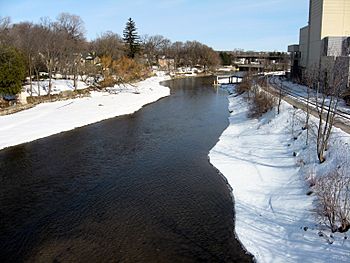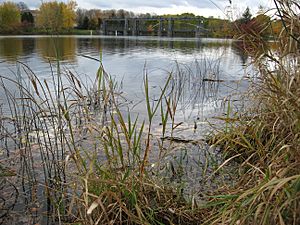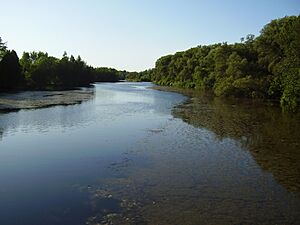Speed River facts for kids
Quick facts for kids Speed River |
|
|---|---|

|
|
| Country | Canada |
| Province | Ontario |
| Physical characteristics | |
| Main source | Orton, Ontario |
| River mouth | Grand River at Cambridge |
The Speed River is a river in southwestern Ontario, Canada. It flows through Wellington County and the Region of Waterloo. The river starts near Orton. It then flows south through Guelph, where the Eramosa River joins it. After Guelph, it goes through the towns of Hespeler and Preston. Finally, the Speed River meets the Grand River in north-west Cambridge.
Guelph Lake: A River's Reservoir
North of Guelph, you'll find Guelph Lake. This lake was created by building a dam across the Speed River. The dam is very important because it helps prevent floods, especially in spring. When there's a lot of rain or melting snow, extra water, called runoff, collects in the Guelph Lake Reservoir. This reservoir is about 1,700-acre (6.9 km2) big. In the autumn, the water is drained out to make space. Then, in summer, the water is slowly released. This helps control the river's flow and keeps it from getting too high or too low.
Parks and Nature Areas Along the Speed River
Many beautiful parks and nature areas are located along the Speed River.
- Guelph Lake Conservation Area: This area is on the shore of Guelph Lake. The Grand River Conservation Authority (GRCA) owns and manages it. It's a great place to enjoy nature.
- Riverside Park in Guelph: This is one of the oldest parks in Ontario. It's built right next to the Speed River. People in Guelph have worked hard to protect the river environment here. They let the river's edge grow naturally. This helps the environment and saves on maintenance. The city wants to protect the river's role in the city. They want to make it part of urban design. They also want to protect the different kinds of plants and animals. They stopped using chemical pesticides and fertilizers. This helps create a natural strip of land, called a "riparian zone". This zone is between the river and the parklands. It provides food and homes for wildlife. It also helps keep the water clean by stopping dirt from washing in. The shade from trees along the river keeps the water cooler. Cooler water has more oxygen, which is good for fish and helps reduce algae.
- Parks in Hespeler (Cambridge): In the town of Hespeler, which is part of Cambridge, there are several parks along the Speed River. These include Jacob's Landing, Riverside Park, Hespeler Mill Pond, and Ellacott Lookout.
- Chilligo Conservation Area: This area in Cambridge is where the Speed River meets Chilligo Creek. The GRCA also owns and manages this special place.
- Idylwild Park Site: The former site of Idylwild Park is on the Speed River in Cambridge. Part of it is now a conservation area. The GRCA owns and manages this section too.
- Riverside Park in Cambridge: This is Cambridge's biggest park. It's also located right on the banks of the Speed River.
- Linear Park: This park in Cambridge is where the Speed River joins the Grand River. It's a key spot where the two rivers meet.
Fishing in the Speed River
The Speed River is home to many different types of fish. You might find smallmouth bass, largemouth bass, rainbow trout, brown trout, and brook trout. Other fish include northern pike, bullhead, carp, and various panfish.
People are working to bring back trout to the Speed River in Guelph. For many years, trout have not been caught in Guelph. Dams and other barriers in the river have made the water warmer. They also stop fish from moving freely to lay their eggs. These issues have made it hard for trout to survive.
Guelph Lake is a popular spot for fishing yellow perch and pike. In the past, the GRCA used to host ice fishing events on Guelph Lake. However, they no longer do this. During winter, the lake and the rest of the conservation area are closed to visitors.



